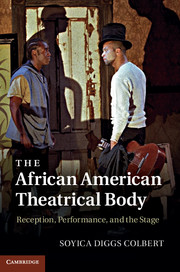Book contents
- Frontmatter
- Contents
- Illustrations
- Acknowledgements
- Overture: rites of reparation
- Chapter 1 Repetition/reproduction: the DNA of black expressive culture
- Chapter 2 Recuperating black diasporic history
- Chapter 3 Reenacting the Harlem Renaissance
- Chapter 4 Resisting shame and offering praise and worship
- Chapter 5 Resisting death: the blues bravado of a ghost
- Chapter 6 Rituals of repair
- Chapter 7 Reconstitution
- Epilogue Black movements
- Notes
- Bibliography
- Index
Chapter 5 - Resisting death: the blues bravado of a ghost
James Baldwin's Blues for Mister Charlie
Published online by Cambridge University Press: 05 November 2011
- Frontmatter
- Contents
- Illustrations
- Acknowledgements
- Overture: rites of reparation
- Chapter 1 Repetition/reproduction: the DNA of black expressive culture
- Chapter 2 Recuperating black diasporic history
- Chapter 3 Reenacting the Harlem Renaissance
- Chapter 4 Resisting shame and offering praise and worship
- Chapter 5 Resisting death: the blues bravado of a ghost
- Chapter 6 Rituals of repair
- Chapter 7 Reconstitution
- Epilogue Black movements
- Notes
- Bibliography
- Index
Summary
The way we find Richard Henry in the opening scene of Blues for Mister Charlie, “face down in the weeds,” recalls perhaps the only lynching victim Americans know by name and sight. Emmett Till's body haunts James Baldwin's play of 1964 much like Toni Morrison's “ghost in the machine.” In 1955 the fourteen-year-old black boy was brutally murdered in Money, Mississippi, for allegedly whistling at a white woman. Although the protagonist of Blues for Mister Charlie, Richard Henry, does not represent Emmett Till, Till's tragic death and the staging of his funeral nonetheless echo throughout the play. As Till's surrogate, to borrow a term from Joseph Roach, Richard's role in the social drama may exceed and differ significantly from the one that Till played even as Richard fills with soundings the vacancy Till left. Blues for Mister Charlie uses a legacy of acoustic resistance modeled in African American cultural productions to present the competing historical narratives that culminated in Till's death, the 1963 death of Medgar Evers (a civil rights activist), and the deaths of thousands of other lynching victims. This chapter provides a critical lens to interpret why certain histories remain ghostly and others emerge as part of the “official” story. Baldwin's play demonstrates, through the articulate, haunting speech of Richard Henry, how the acoustic legacies left by the victims of lynching inform the shape of historical narratives. Through the play, Baldwin situates the death of Till as a sequence of events that may not be consolidated by one moment in time. The dismembered remains of the victims of lynching have a visual legacy in historical and artistic texts. Intervening in the visual history of lynching, the play, however, does not translate onto the page Till's alleged whistle, Evers' cries for desegregation, or the moans of lynching victims that preceded them. Instead, it theorizes the processes that mute certain sounds and amplify others.
As others have argued, including Marvin Carlson, Joseph Roach, Elin Diamond, Herbert Blau, Richard Schechner, Bert O. States, Harry J. Elam, Jr., and Alice Rayner, the theater is essentially a ghosted space filled with the possibility of arresting judgment and forcing “recognition or reknowing or unforgetting” in Rayner's terms. The disruptive force of the theater inheres in its ability to render a familiar sight unfamiliar. For example, as I have argued in previous chapters, The Star of Ethiopia and Color Struck rendered the black female body unfamiliar through opacity and elision. African American theater has the ability to make the “familiar world suddenly [seem] strange and new or impossible” through the repeated display of black bodies and the simultaneous reproduction of (un)familiar performances. The disjunction or connection between certain bodies and certain acts has the potential to recalibrate looking and recall the ghostly histories that supplement viewing practices and therefore are left purposefully unsaid. As Carlson notes, “theatre is in an important sense haunted by a preexisting text.” Throughout this book I have shown how race as a discursive category and political force establishes viewing practices that haunt the African American theater and enable the critical work of many of the plays I discuss even as they limit the commercial viability of several of them. Blues for Mister Charlie bridges a gap between theater as a ghosted medium and other forms of cultural production by demonstrating the way other modes register ghosting through the acoustic.
- Type
- Chapter
- Information
- The African American Theatrical BodyReception, Performance, and the Stage, pp. 159 - 193Publisher: Cambridge University PressPrint publication year: 2011

